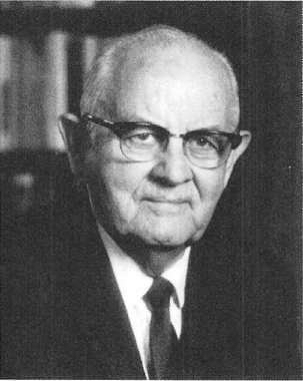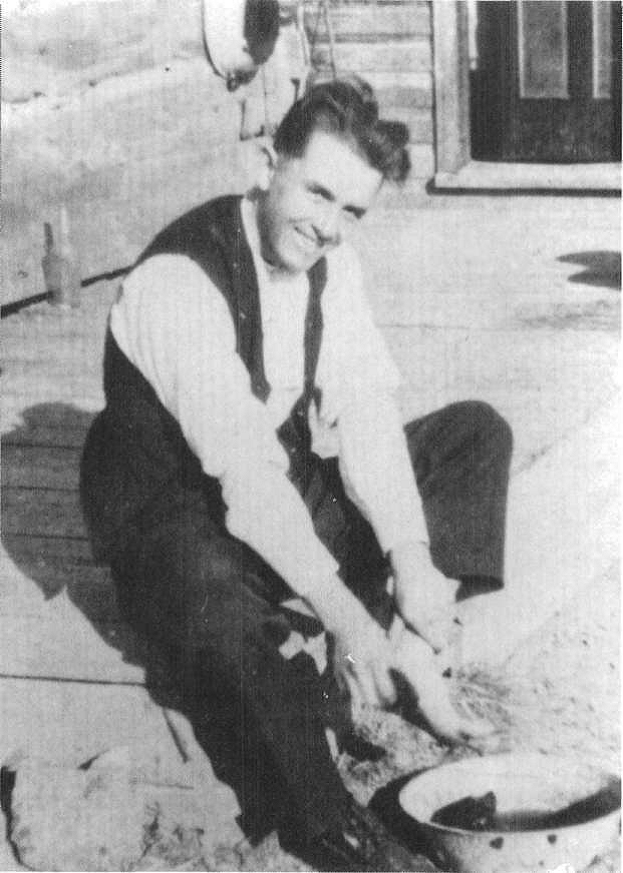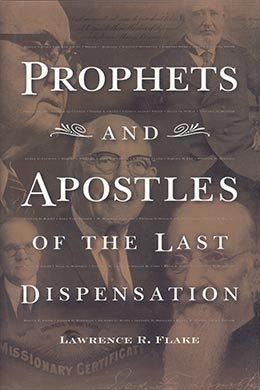Spencer Woolley Kimball
Lawrence R. Flake, Prophets and Apostles of the Last Dispensation (Provo, UT: Religious Studies Center, Brigham Young University, 2001), 113–22.

Born: 28 March 1895, Salt Lake City, Utah
Quorum of the Twelve Apostles: 7 October 1943 (age 48)
Acting President of the Quorum of the Twelve: 23 January 1970
President of the Quorum of the Twelve: 7 July 1972
President of the Church: 30 December 1973 (age 78)
Died: 5 November 1985 (age 90), Salt Lake City, Utah
In the hayfield where young Spencer Kimball was tromping hay for his older brothers, he could hear the meetinghouse bell sound for Primary. An unusually conscientious child, he had kept a perfect attendance record at all his Church meetings for years, and he asked permission to leave to go to Primary. His brothers would not grant his request, stating that he was needed in the work that afternoon. Spencer knew that his father would let him go if he were there, so as soon as he saw the opportunity, he slid off the wagon unnoticed and was halfway to the chapel before his brothers missed him. [1]
This high sense of duty to the Church seemed born in Spencer Woolley Kimball. His father, noting the boy’s remarkable obedience, prophesied to a neighbor one day, “That boy, Spencer, is an exceptional boy. He always tries to mind me, whatever I ask him to do. I have dedicated him to be one of the mouthpieces of the Lord—the Lord willing. You will see him some day as a great leader. I have dedicated him to the service of God, and he will become a mighty man in the church.” [2]
In 1898, when Spencer was three, his father, Andrew Kimball, who was one of Elder Heber C. Kimball’s sixty-six children, moved his family from Salt Lake City to Thatcher, Arizona, accepting a call to serve as president of the St. Joseph Stake in the Gila Valley, a position he held for twenty-eight years. Here Spencer grew up with many hardships. At the age of ten he suffered paralysis of his face, but through the ministrations of the priesthood, he was freed from this affliction. [3] That same year he nearly drowned while attending a picnic with his family. When Spencer was eleven, his mother died, leaving eight children. [4] Two years later the motherless boy was stricken with typhoid fever and lay ill for many weeks. Upon the trail of this illness came small pox, from which he was also able to recover, miraculously escaping death.
Spencer Kimball graduated with honors from the Gila Academy, a high school owned by the Church. He combined his years of schooling with months of hard summer labor on a nearby dairy farm, where he worked strenuously from morning until night. Shortly before the outbreak of World War I, he received a call to the Swiss German Mission. Due to the perilous conditions abroad, his assignment was changed to the Central States. After fulfilling a successful mission, Elder Kimball returned to Arizona and attended the University of Arizona at Tucson.
One summer he and his foster brother were earning money for school by digging a well on a ranch. Again a prophecy touched his life—this time he made the prophecy. The boy’s only contact with the outside world was the Graham County Guardian, a newspaper they received once a week. Brother Kimball recalled, “One week the paper showed a beautiful girl
 Elder Spencer W. Kimball as a missionary, ca. 1914
Elder Spencer W. Kimball as a missionary, ca. 1914
on the front page. It was Miss Camilla Eyring, who was to teach school at the Gila Academy the coming year. It gave all the information about her. I told my foster brother, and myself, that this girl would be my wife. ‘I am going to marry that girl’ I said.” [5] Camilla Eyring had moved with her family to Arizona when the Mormons fled from Pancho Villa’s armies in Mexico. Spencer succeeded in meeting and courting Miss Eyring the following September and married her one month after that. The Kimballs became the parents of three sons and one daughter.
For six years Spencer Kimball served as clerk in the Gila Stake, where his father was president. Upon Andrew Kimball’s death, his son Spencer became a counselor in the stake presidency and, fourteen years later, became the president of a division of that stake—the newly formed Mt. Graham Stake, which extended all the way to El Paso, Texas. During those years of Church service in Arizona, Brother Kimball worked as a banker, insurance man, real estate agent, and radio broadcasting company owner. He was always busy but still found time to serve the community in education, USO and war work projects, flood disaster rehabilitation, irrigation, Scouting, Rotary, Chamber of Commerce, and so forth. In July 1943 Spencer Kimball received a telephone call that fulfilled the prophecy of a loving father concerning his little son: President J. Reuben Clark informed him of his calling to serve in the Quorum of the Twelve. The stunned stake president responded, “Not me, Brother Clark! You can’t mean that!” [6]
The days between this phone call and his sustaining and setting apart on 7 October 1943 found Brother Kimball in a great struggle for a feeling of adequacy in his new calling. His deep humility and consuming desire to be a valiant servant caused him to seek the Lord in mighty prayer. In his first conference address after being sustained a member of the Twelve, he said, “I remember reading that Jacob wrestled all night, ‘until the breaking of the day,’ for a blessing; and I want to tell you that for eighty-five nights I have gone through that experience, wrestling for a blessing. Eighty-five times, the breaking of the day has found me on my knees praying to the Lord to help me and strengthen me and make me equal to this great responsibility that has come to me.” [7]
At other times in his life, President Kimball also underwent great spiritual struggles that strengthened him and deepened his character. Elder Boyd K. Packer, who served with him in the Quorum of the Twelve, wrote:
There have been other trials too, greater far than those we have mentioned, too sacred to publish, but he has told his Brethren of the Twelve. On two occasions, each time when he was on assignments to stake quarterly conference, and each time not related to problems incident to the conference, there was unleashed against him the very might of the adversary. He endured those hours, not to be recorded here, something akin to what his grandfather had experienced when, as an apostle of the Lord, he opened the work in England, something not unlike the Prophet Joseph experienced as he first knelt in the Grove. These trials have made him humbly dependent upon the power of the Lord. [8]
Elder Kimball’s struggles with physical afflictions returned as he shouldered the responsibilities of the apostleship. In 1948 he suffered a series of heart attacks from which he recovered by spending a period recuperating in the high country of his beloved Arizona. Three years later he lost his voice through a serious throat ailment and obtained its restoration through a priesthood blessing. His throat was again afflicted in 1957—this time surgery for malignancy was required. He traveled East to undergo an operation in which one vocal chord and part of another were removed. Again beseeching the Lord to restore the voice he needed so desperately to complete his mission of preaching the gospel, Elder Kimball was blessed to acquire a resonant, appealing voice unmistakable to and loved by the members of the Church throughout the world. Still more difficulties arose in 1972 when he underwent open-heart surgery performed by a world-renowned physician, Dr. Russell M. Nelson, who would later be called to the Quorum of the Twelve. President Kimball often jokingly referred to him as “a man who was very close to my heart.” For a man of seventy-seven, the risk of this complex operation was enormous, and his miraculous recovery was acknowledged throughout the Church. When he became president of the Church in 1973, the Lord’s gift of health to him was apparent. His doctor reported to him at that time: “In a complete assessment of your general physical status, all of our findings were indicative of superb structure and function of your body.” [9]
As an apostle, Elder Kimball traveled literally all over the world and served on numerous assignments, notable among which was his quarter-century as head of the Lamanite program. Andrew Kimball was in the midst of a ten-year mission to the Lamanites when Spencer was born, and Spencer seemed endowed with a wellspring of love for them. As a boy he was intrigued with a trunk full of Native American mementos, crafts, and pictures his father had collected. He loved to hear and learn the Native American chants his father would sing to him and his brothers and sisters. His patriarchal blessing, which he received when he was nine years old, proclaimed, “You will preach the gospel to many people, but more especially to the Lamanites, for the Lord will bless you with the gift of language and power to portray before that people, the gospel in great plainness. You will see them organized and be prepared to stand as the bulwark ‘round this people.’” [10] His office was decked with the gifts of love from this people of his choice, including a beautiful headdress given him by a Sioux tribe that adopted him and gave him the name “Good Voice Eagle.”
Two fine books are a credit to President Kimball and a blessing to those who read them—The Miracle of Forgiveness, published in 1969, and Faith Precedes the Miracle, published in 1972.
Upon the sudden and unexpected death of his beloved friend President Harold B. Lee, the mantle of the prophet rested upon Spencer Kimball. He said, “We prayed it would never happen; our prayers were for President Harold B. Lee. Night and morning every day, we prayed for a long life and the general welfare of President Lee. I knew the responsibility could fall to me, but I did not seek it. Now I will do my best.” [11] On 30 December 1973 the members of the Twelve gathered in the Salt Lake Temple to ordain and set apart the new president of the Church. As they convened, President Kimball himself played “I Need Thee Every Hour” on the piano and the apostles sang. Then each of them in turn bore his witness that Spencer Kimball was the man the Lord wanted to preside over the Church.
Once in a general conference as a member of the Twelve, Elder Kimball had expressed the idea that the world is often blessed by the obscure birth of an infant who grows to be a great man. In the beautifully poetic style characteristic of his sermons, he said, “When theologians are reeling and stumbling, when lips are pretending and hearts are wandering, and people are ‘running to and fro, seeking the word of the Lord and cannot find it’—when clouds of error need dissipating and spiritual darkness needs penetrating and heavens need opening, a little infant is born.” [12] Without knowing what the future held for him, certainly Spencer W. Kimball was a child of his own description—a child of promise as prophesied by his righteous father. Of President Kimball’s mission on the earth, Elder Packer wrote: “And so came Spencer Woolley Kimball. The Lord had managed those humble beginnings. He was not just preparing a businessman, nor a civic leader, nor a speaker, nor a poet, nor a musician, nor a teacher—though he would be all of these. He was preparing a father, a patriarch for his family, an apostle and prophet, and a president for his Church.” [13]
President Kimball’s age, seventy-eight, and his history of poor health may have caused some members of the Church to expect that his would be a short and relatively uneventful administration. Perhaps even President Kimball thought that at first. On the day he became president of the Church, a reporter for the New York Times asked if he expected to make any major changes. He replied, “I would hope to follow along pretty well the path we have already been treading.” He also observed, however, that “we believe the Lord directs us in all these important things.” [14]
Within days it became apparent that the Lord had preserved Spencer Kimball to do a mighty work as his prophet. He called on the members of the Church to “Do it” and to “Lengthen your stride and quicken your pace,” declaring: “We have paused on some plateaus long enough. The time has come to move ahead in a major way.” Over the next eleven years until his death in 1985, he lifted and inspired the Church with his emphasis on missionary work. An article in the Ensign, written by Elder Neal A. Maxwell a month after President Kimball’s death, lists some of the “milestones” in the administration of this great prophet. The list is four columns long, consisting of one-hundred twenty-five significant contributions to the building of the Lord’s kingdom. On that list are two milestones that Elder Bruce R. McConkie singled out as being of monumental significance: “There have been a couple of things happen in our lifetimes that have had more influence and will yet have a greater impact upon the Church than anything else of which I am aware, and both of them have come to pass as a result of the inspiration of heaven to President Kimball. . . . I think that, organizationally, the First Quorum of the Seventy is the greatest thing that has happened in our lifetimes, and that, doctrinally, the taking of the priesthood to all people of every race and culture is the most significant thing that has happened.” [15]
It would be difficult to overstate the importance of this latter revelation, which has come to be called the priesthood revelation and is announced in the Doctrine and Covenants as Official Declaration 2. President Kimball’s son wrote, “Nothing so dramatic as this revelation had happened in several generations. The electrifying news that every race could receive the blessings of priesthood and temple caused nearly universal rejoicing, not only because of the extension of blessings but because it demonstrated the principle of continuing revelation.” [16] President Kimball had been concerned for many years with the difficulty and heartbreak of some faithful families who did not enjoy the full blessings of the priesthood because of their lineage. The concern had grown particularly acute in places such as Brazil, where the Church was growing rapidly and racial lines were blurred. In the early 1960s, President McKay had had to decline sending missionaries to African countries such as Nigeria and Ghana, even though groups of people desiring to join the Church had requested official representatives of the Church to teach them. President Kimball had made this issue a matter of fervent prayer for many years and at length felt inspired to draft by hand a statement extending the priesthood to all worthy male members, which he read to his counselors in the First Presidency on 30 May 1978. A few days later, Thursday, 1 June, all of the apostles (except for two who were out of the country) came fasting to the temple to discuss the matter. All of those present witnessed a miraculous outpouring of the spirit that day, leaving them a sure confirmation that President Kimball’s direction was the will of the Lord in this matter. The following week, during the Thursday meeting of the Twelve, President Kimball read the final statement prepared for the press and received the approval of each of the apostles. The statement was released to the press Friday, 9 June 1978, creating a far-reaching impact on missionary work and all aspects of the restored Church. [17]
When President Kimball died at age ninety, his counselor Gordon B. Hinckley recalled once trying to get him to slow down a little. President Kimball responded, “Gordon, my life is like my shoes, to be worn out in service.” President Hinckley observed, “He so lived. He so died. . . . He has gone to the company of Him whose servant he was, even the Lord Jesus Christ of whom he bore a witness and testimony.” [18]
Notes
[1] Francis M. Gibbons, Spencer W. Kimball: Resolute Disciple, Prophet of God (Salt Lake City: Deseret Book, 1995), 23.
[2] “Early Prophecies Made About Mission of Elder Kimball,” Church News, 18 November 1961, 16.
[3] Edward L. Kimball and Andrew E. Kimball Jr., Spencer W. Kimball: Twelfth President of the Church of Jesus Christ of Latter-day Saints (Salt Lake City: Bookcraft, 1977), 40.
[4] Kimball and Kimball, Spencer W. Kimball, 45.
[5] J. M. Heslop, “Pres. Kimball’s Counsel: Keep Commandments,” Church News, 5 January 1974, 4.
[6] Lowell Durham Jr. and Melvin Leavitt, “President Spencer W. Kimball,” New Era, February 1974, 6.
[7] Improvement Era, December 1943, 678.
[8] Boyd K. Packer, “President Spencer W. Kimball: No Ordinary Man,” Ensign, March 1974, 5.
[9] Packer, “President Spencer W. Kimball,” 5.
[10] Packer, “President Spencer W. Kimball,” 12.
[11] Heslop, “Keep Commandments,” 4.
[12] Conference Report, April 1960, 84.
[13] Boyd K. Packer, “President Spencer W. Kimball,” 3.
[14] Eleanor Blau, “New Mormon Head: Spencer Woolley Kimball,” New York Times, 1 January 1974.
[15] Bruce R. McConkie, The Foolishness of Teaching (Salt Lake City: The Church of Jesus Christ of Latter-day Saints, 1981), 1.
[16] Edward L. Kimball, “Spencer W. Kimball,” in The Presidents of the Church, ed. Leonard J. Arrington (Salt Lake City: Deseret Book, 1986), 414.
[17] Gibbons, Spencer W. Kimball, 294–97.
[18] “Pres. Kimball Was a ‘Man Who Knew the Lord,’” Church News, 17 November 1985, 14.
